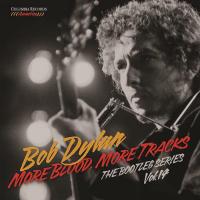Bob Dylan's "More Blood, More Tracks The Bootleg Series Vol. 14" Review + Exclusive Interview With Co-Producer Steve Berkowitz
Armed with a trove of new songs, on September 16th 1974 Dylan entered Phil Ramone's A&R studios—a former Columbia Records venue with which Dylan was well familiar—and began recording the well-rehearsed, fully realized stripped-down performances that did not become the final familiar album.
During the four days at A&R Dylan repeatedly played the songs solo as he'd done in November of 1961 for his very first Columbia album, adding then subtracting a bass player (Tony Brown) and a small backing band until he'd gotten the desired results—but all was recorded "live" and without overdubs. Dylan didn't even wear headphones.
Columbia Records began what turned out to be premature promotion, which included a limited edition pre-release LP sent to writers and radio stations. Those records became and probably still are highly sought after pricey collectibles.
That December, while in Minnesota visiting family, Dylan had second thoughts. On December 27th, 1974 he entered a local studio (Sound 80 Studio), hired a back up band and re-recorded much of the album. Back in New York Dylan and Ramone (who passed away March 30th, 2013, age 79, and whose real name was Philip Rabinowitz) combined performances from the New York and Minneapolis sessions to produce the finished album that included the common-at-the time speeding up of some songs by as much as 2 and 3% and adding Ramone's personalized sonic polish.
The 12 song More Blood, More Tracks.... available on a single CD and double vinyl LP, is another version of the classic album—one that may be even more appealing than the original, while the deluxe box 6 CD box set presents in chronological order the New York and available Minnesota recording sessions in their entirety with multiple takes, breakdowns and studio chatter.
Co-producers Jeff Rosen and Steve Berkowitz have remixed all of the available tracks to produce an intimate "live in the studio" experience that eschews the original's commerce-oriented reverb, compression, pitch changes and vocal effects, giving you a more transparent window onto the original performances.
The 11 song Blood on the Tracks re-telling, which reprises the original track order, all sourced from New York recordings, begins with "Take 3, Remake 3" of "Tangled Up in Blue" with Dylan backed by bassist Tony Brown. It was the final take on the final day of recording in New York, by which time the two were in full musical communication.
The chosen version of "You're a Big Girl Now" (Track 6) is the first song recorded on the first day at A&R. Though the take was quickly discarded and replaced on the final album with another, as you listen all these years later to this solo performance you may wonder why—at least until you re-visit the one on the original LP, at which point you'll be glad to have both! The 9/19/74 performance of "Idiot Wind" with bass is the same one used in 1991 on the very first "The Bootleg Series", though here minus Paul Griffin's organ overdub heard there.
In the audiophile world, listeners often long for the transparent, magical "straight shot" into the studio, minus the post production and mastering tricks often added to increase a recording's commercial appeal. If ever a recording demanded that kind of treatment it would be these Blood on the Tracks sessions carefully re-mixed on vintage gear to create the ultimate "you are there" in the studio with Bob Dylan experience. Six tracks are with bass accompaniment and five are solo. The sound here is as "you're in the studio" as it can possibly be. Ryan K. Smith (un-credited but scribe marks on lead out groove area) cut lacquers from the 96/24 files and MPO pressed perfectly flat, quiet records. You'll love Geoff Gans' art direction—especially the record labels. My only complaint is the flimsy jacket.
Completists will want the deluxe edition, with every available recorded scrap that includes some takes thought to have been erased but found on a running mono monitoring tape, but for many this version will more than suffice. As you'll hear in the interview, only the Minneapolis songs used on the original album were in the vault on multi-track tape. The whereabouts of the others is not currently known—if they still exist.
Please listen to and enjoy the interview with co-producer Steve Berkowitz.




